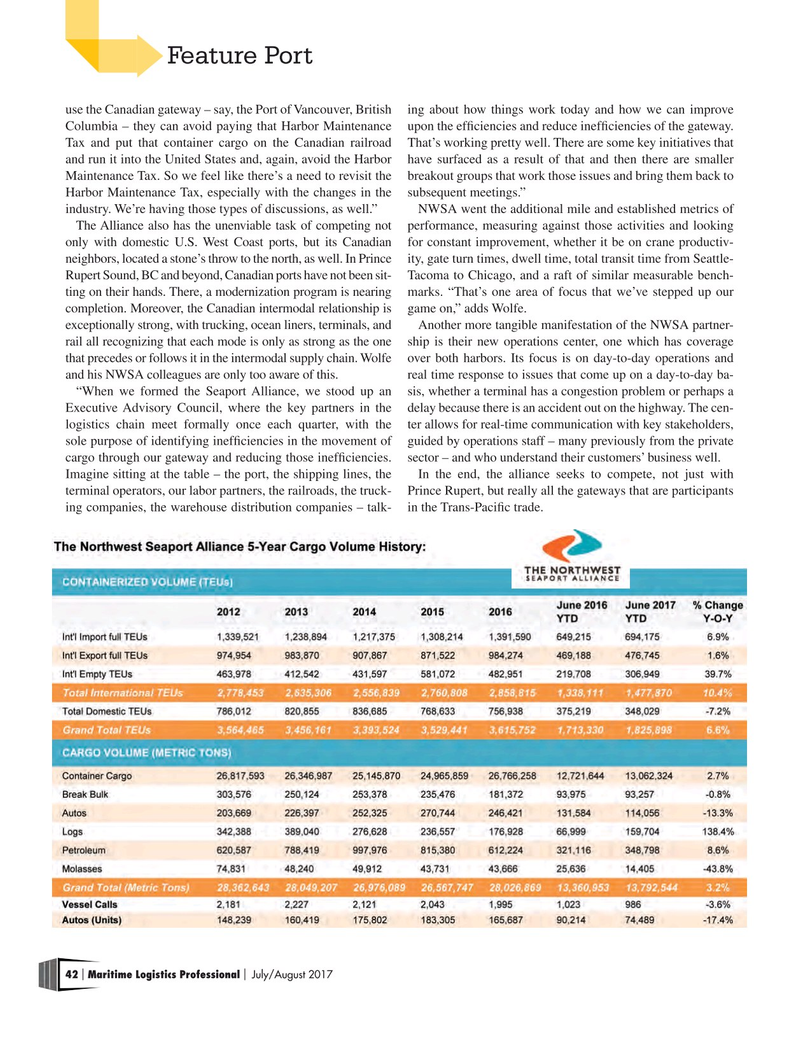
Page 42: of Maritime Logistics Professional Magazine (Jul/Aug 2017)
PORTS & INFRASTRUCTURE
Read this page in Pdf, Flash or Html5 edition of Jul/Aug 2017 Maritime Logistics Professional Magazine
Feature Port use the Canadian gateway – say, the Port of Vancouver, British ing about how things work today and how we can improve
Columbia – they can avoid paying that Harbor Maintenance upon the effciencies and reduce ineffciencies of the gateway.
Tax and put that container cargo on the Canadian railroad That’s working pretty well. There are some key initiatives that and run it into the United States and, again, avoid the Harbor have surfaced as a result of that and then there are smaller
Maintenance Tax. So we feel like there’s a need to revisit the breakout groups that work those issues and bring them back to
Harbor Maintenance Tax, especially with the changes in the subsequent meetings.” industry. We’re having those types of discussions, as well.” NWSA went the additional mile and established metrics of
The Alliance also has the unenviable task of competing not performance, measuring against those activities and looking only with domestic U.S. West Coast ports, but its Canadian for constant improvement, whether it be on crane productiv- neighbors, located a stone’s throw to the north, as well. In Prince ity, gate turn times, dwell time, total transit time from Seattle-
Rupert Sound, BC and beyond, Canadian ports have not been sit- Tacoma to Chicago, and a raft of similar measurable bench- ting on their hands. There, a modernization program is nearing marks. “That’s one area of focus that we’ve stepped up our completion. Moreover, the Canadian intermodal relationship is game on,” adds Wolfe.
exceptionally strong, with trucking, ocean liners, terminals, and Another more tangible manifestation of the NWSA partner- rail all recognizing that each mode is only as strong as the one ship is their new operations center, one which has coverage that precedes or follows it in the intermodal supply chain. Wolfe over both harbors. Its focus is on day-to-day operations and and his NWSA colleagues are only too aware of this. real time response to issues that come up on a day-to-day ba- “When we formed the Seaport Alliance, we stood up an sis, whether a terminal has a congestion problem or perhaps a
Executive Advisory Council, where the key partners in the delay because there is an accident out on the highway. The cen- logistics chain meet formally once each quarter, with the ter allows for real-time communication with key stakeholders, sole purpose of identifying ineffciencies in the movement of guided by operations staff – many previously from the private cargo through our gateway and reducing those ineffciencies. sector – and who understand their customers’ business well.
Imagine sitting at the table – the port, the shipping lines, the In the end, the alliance seeks to compete, not just with terminal operators, our labor partners, the railroads, the truck- Prince Rupert, but really all the gateways that are participants ing companies, the warehouse distribution companies – talk- in the Trans-Pacifc trade. 42 Maritime Logistics Professional July/August 2017 | |

 41
41

 43
43
